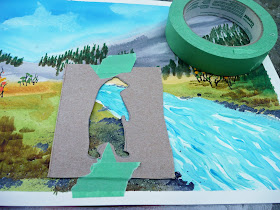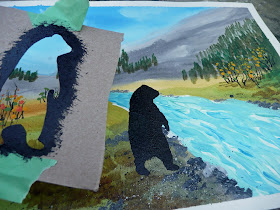I have a thing for paperbag books.....I love creating them.
On Wednesday I leave for the
Fernie Writer's Conference where I'll be teaching 8-10 year olds how to make these books as well as lots of other projects combining the Visual Arts with writing.
You can find directions on how to make a paperbag book from a previous post
HERE:

We start by painting the front and back cover. When you lay your book out flat you see both. Just be sure to remind the kids that the front cover is on the right. If they don't have the title figured out yet
that's ok you can add it later. You also don't have to do this book in order........if the kids aren't sure what to put here
we can always work on these pages later.
The purpose of this paperbag book is to help the students organize and expand their ideas for writing their story.
So the first page after the cover is about the main character:
- who is it
- hero, villain, common Joe
- special characteristics
They also have to have a drawing, painting, or cartoon image of this character.

With the flap you can show the minor characters or where the main character ends up at the end of the story. In my sample book my
Peter the owl becomes
Pierre the tour guide.
On the 3rd page I included a spin wheel in the book. I used mine here to describe the different settings I want my character to visit during my story.
I wasn't going to put a Fortune Teller into my story but I might want to incorporate it. Other ideas for the wheel could be the character looking out a window, watching a T.V., staring at reflections in a pond........there are lots of possibilities. I just want the kids to have fun with it.
I've made these wheels before
(Color Wheel Gecko).
For the paperbag book I cut out a circle that is a little smaller than the page. I used a template and cut the circle out of posterboard.
Punch a hole thru the center using an awl or knitting needle. I usually just eyeball the center but you can also draw 2 lines across the circle. Where they meet is the center. Lay the circle in place on the page (make sure it sticks out a little on the side) and make a pencil mark thru the hole onto the paperbag page.
Cut a smaller circle, punch a hole and put in a paper fastener.
Put some white glue over the circle and top of the fastener.
Open up the bag end on this page and place your gluey little circle inside. You want the top of the fastener to match up with your pencil mark you made on the outside.
I can usually feel it thru the paper....adjust position of gluey circle if needed.
Let glue dry.
Now you need to cut out your window. Here we are using a circle shape. Make sure your window shape is small enough to fit into you wheel. You want a bit of space around the center as well as a little on the side.
Trace onto your paperbag page. Use the pencil mark of the center of the wheel as a guide for placement.
Cut out shape using paper cutter and scissors. Make sure you only cut the top page not the sides of that bag. You'll be cutting away some of the little circle that's holding your fastener. That's OK. If the fastener prong is in the way of cutting just move it to the side.
For the workshop I have done this all ahead of time for the kids.
If you want you can cut a piece of transparency to cover the window. I cut them small enough to fit without covering the fastener.

I then just open the bag portion and tape into place on the sides of the transparency.

The kids will illustrate their scene and then the wheel. I divide the wheel up like a pie, each piece the size of the window shape. Place wheel on the fastener and you have spinner which changes the scene thru the window.

The next 2 pages of the book use little inchie squares and incorporate a storyboard idea to help the kids sequence their plot. It also includes a little spinner for the twist. I go through the directions for the spinner in this
POST.

I used the flap on this page to write out some alternate endings or you could map out some other possibilities for your story.

On the last pocket page I've made a puppet theater. This will give the kids a way the can act out their story trying different dialogue or sequencing. I know my 8 yr. old gets a lot of good practice in storytelling by having to put on a puppet show.

To make the puppet theater trace out a square shape for your theater that is smaller than the page.

Cut out the square with scissors or paper cutter taking care to only cut the top page and not the sides of the bag.

Now you could just leave it like that but I want it to be a little more durable for the kids so I cut out a frame for the theater from watercolor paper and then glued this into place.

We then make our puppets. Paint or draw out your characters onto posterboard and cut out.

I get the kids to add some embellishments to their puppets for a little WOW factor.

The puppets are then glued on to wooden coffee stir sticks (Dollar Store). Let dry.

For the backgrounds I precut some wc paper that fits into the pocket. the kids then paint the different settings. Let dry and then store in the pocket. These switch out quite easily.

The pocket is also where you store your puppets. You can label the end of each stick to keep your puppets organized for the show.

That's it. I can't wait to see what ideas the kids have for their paperbag books. I'm hoping to post the results as well as some of the other projects we will be working on.
See from Fernie next time!

 I have been hanging out at the cabin in BC trying to will that sun to come out and painting some scenes from last year's trip to Paris.
I have been hanging out at the cabin in BC trying to will that sun to come out and painting some scenes from last year's trip to Paris. At Fernie I had an extra project up my sleeve just in case we had time. We didn't but I thought I'd post it for you.
At Fernie I had an extra project up my sleeve just in case we had time. We didn't but I thought I'd post it for you.  Take some of your scrap paper, I used newspaper and old book pages. Paint it in colors to represent the river. Use brush strokes to capture the moving water. If you want you can add a little glitter glue for that shimmer on the water.
Take some of your scrap paper, I used newspaper and old book pages. Paint it in colors to represent the river. Use brush strokes to capture the moving water. If you want you can add a little glitter glue for that shimmer on the water. Take a sheet of wc paper and tape it down on your art board. Sketch out a mountain landscape with a river. Paint in your sky.
Take a sheet of wc paper and tape it down on your art board. Sketch out a mountain landscape with a river. Paint in your sky. Lift out a few clouds with kleenex or paper towel while the paint is still wet.
Lift out a few clouds with kleenex or paper towel while the paint is still wet. Paint in your middle ground. Add some trees. A good way to make fir trees is to let the brush do all the work. Using a flat hold it vertically and just stamp in the tree shapes. I usually have a few colors on the brush for that natural color variation. Here I'm using some green and brown.
Paint in your middle ground. Add some trees. A good way to make fir trees is to let the brush do all the work. Using a flat hold it vertically and just stamp in the tree shapes. I usually have a few colors on the brush for that natural color variation. Here I'm using some green and brown. Paint in your river. I'm using thick paint (impasto) to help simulate the rushing water.
Paint in your river. I'm using thick paint (impasto) to help simulate the rushing water. Set your painting aside to dry. Now make up your stencil. Find a good bear picture or shape you want to use. Trace it out onto cardboard.
Set your painting aside to dry. Now make up your stencil. Find a good bear picture or shape you want to use. Trace it out onto cardboard. Then tape back together. Tack in place lightly onto your painted background.
Then tape back together. Tack in place lightly onto your painted background. Take some black paint and pounce into the stencil.
Take some black paint and pounce into the stencil. Carefully remove the stencil to reveal your black bear. Let dry. You can add a dot of white paint for an eye and a nose if your want.
Carefully remove the stencil to reveal your black bear. Let dry. You can add a dot of white paint for an eye and a nose if your want. For this project I wanted to concentrate on the river so list all the words you can come up with to describe the water.
For this project I wanted to concentrate on the river so list all the words you can come up with to describe the water. From your painted scrap papers cut out some wavy pieces and glue into the river.
From your painted scrap papers cut out some wavy pieces and glue into the river. You can also look thru your old book pages (I buy old kids books at garage sales and book sales or collect discards from the library)to find words that describe the river or other parts of the picture. Glue these into place.
You can also look thru your old book pages (I buy old kids books at garage sales and book sales or collect discards from the library)to find words that describe the river or other parts of the picture. Glue these into place. Using the words write a few sentences about the composition. Sorry about picture quality but I'm at that cabin. (no scanner) This one says "It was a beautiful day in the woods. A hungry bear searched for some delicious fish."
Using the words write a few sentences about the composition. Sorry about picture quality but I'm at that cabin. (no scanner) This one says "It was a beautiful day in the woods. A hungry bear searched for some delicious fish."  P.S. Thanks everyone for all your wonderful comments. I love to hear from you all, I've tried to answer back in the comments but recently blogger won't let me, I just end up in a acoount verification loop over and over again, but I do read them all!
P.S. Thanks everyone for all your wonderful comments. I love to hear from you all, I've tried to answer back in the comments but recently blogger won't let me, I just end up in a acoount verification loop over and over again, but I do read them all!









































